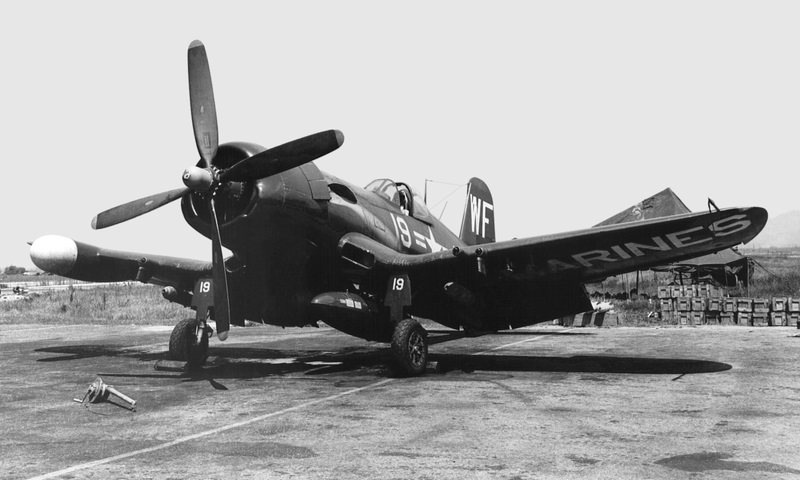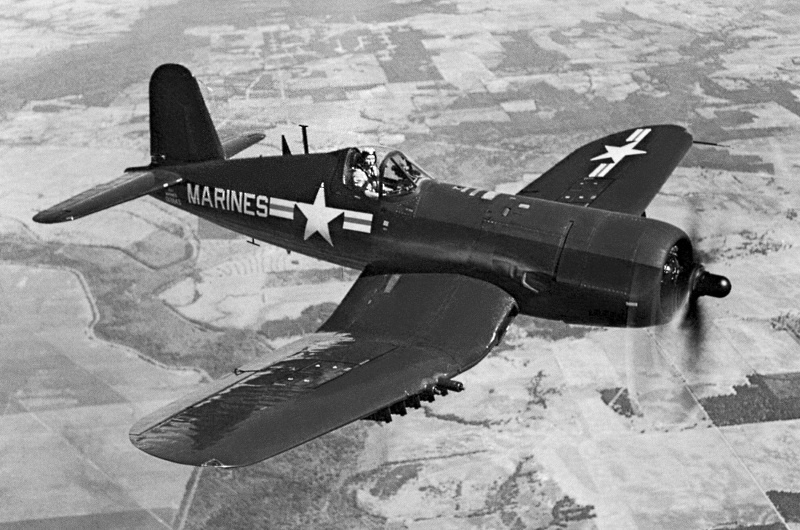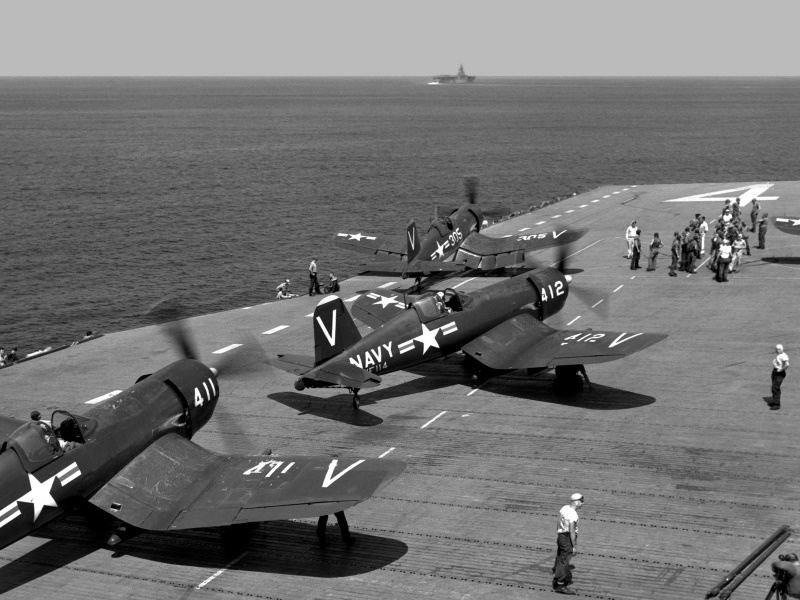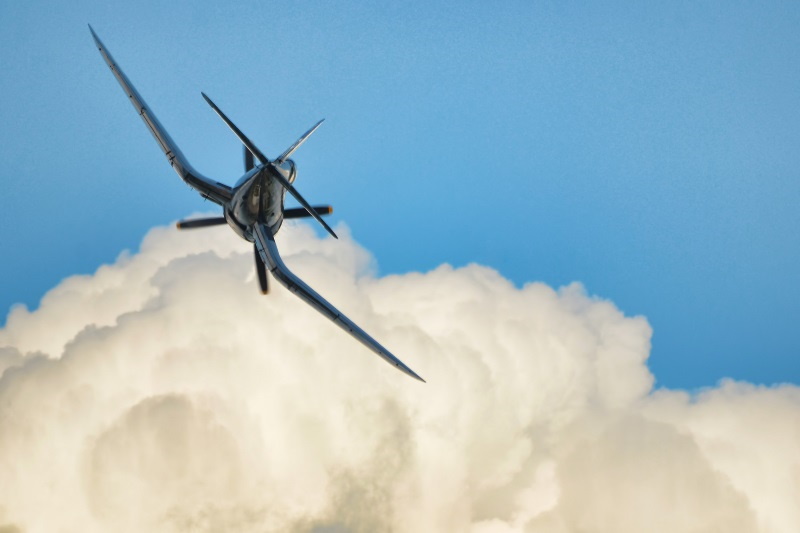
* The Corsair continued to soldier on in the postwar period, with new variants introduced, and seeing combat with the Marines in Korea. It also saw combat with French forces in Indochina. Today, it lingers as a prize warbird. This chapter discussed the Corsair's postwar career -- and also the Boeing "XF8B-1" experimental heavy fighter, comparable to the Goodyear F2G-2 Corsair, but with only three XF8B-1 flight prototypes built.
* As mentioned, F4U-4s continued to be built by Vought in the postwar era, and in fact major new Corsair variants were introduced. Fit of the R-2800-3W engine with 1,716 kW (2,300 HP) take-off power resulted in the "F4U-5", with the engine mounted on an angle two degrees below the centerline to improve the pilot's view, as well as to provide improved longitudinal stability. There were small distinctive "cheek" inlets along either side of the lower lip of the cowling. Top speed was 743 KPH (462 MPH).
Other features of the F4U-5 included an improved cockpit layout, with folding seat armrests, a slightly raised power-actuated canopy, and other niceties to improve pilot comfort and effectiveness; a fully retractable tailwheel; fully metal outer wing panels (finally!); refinements to control surfaces to improve handling; and a flat armor glass windscreen, though that may have been fitted to late-production F4U-4s as well.
The F4U-5's armament consisted of four M3 (T-31) 20-millimeter cannon, with a total of 924 rounds of ammunition. Provision for eight HVARs, two 450-kilogram (1,000-pound) bombs, and a centerline external fuel tank were retained. The launch stubs for the HVARs were rearranged in a staggered configuration for some reason. The cannon and pitot tube had an electrical heating system to allow them to operate properly in extreme cold conditions.
Vought built 223 F4U-5s. There was further production of subvariants:

* During production of the F4U-5, Corsair manufacturing moved from the Vought plant in Connecticut to a facility in Dallas, Texas. Although by this time the Corsair was outmatched in air combat by the new jet fighters, it was still an excellent attack aircraft, and so Vought designed an optimized close air support variant of the Corsair, originally to be designated the "F4U-6" but going into service as the "AU-1", with the "A" emphasizing its attack role.
The AU-1 featured extensive armor protection, making it substantially heavier and significantly slower than the F4U-5. Some sources claim it was hard-pressed to reach 400 KPH (250 MPH), but that might have been with a full warload, and wouldn't be surprising under such circumstances. It featured an R-2800-83W Double Wasp engine with 1,716 kW (2,300 HP) take-off power but only a single-stage supercharger; as a "mudfighter", the AU-1 would operate at low altitudes and so a two-stage supercharger or turbocharger system was regarded as unnecessary. The engine was oriented at two degrees below the centerline, just like in the F4U-5, but the two cheek inlets were moved to under the belly, to ensure better armor protection.

One particularly noticeable change in the AU-1 was that the four stub pylons for HVARs under each wing were switched to five small stores pylons, either for HVARs or light bombs. Total warload of the AU-1 was a respectable 1,815 kilograms (4,000 pounds). Armament of four M3 cannon, with a total of 924 rounds of ammunition, was retained. Roughly 111 AU-1s were built in all, with the type going into service with the US Marine Corps in Korea in 1952.
* During the Korean War, the Corsair was used mostly in the close air support role. There were dogfights between F4Us and enemy Yak-9 fighters early in the conflict, but when the enemy introduced the fast MiG-15 jet fighter the Corsair was outmatched, though one Marine pilot did get lucky. On 9 September 1952 a MiG-15 made the mistake of getting into a turning contest with a Corsair piloted by Captain Jesse G. Folmar, with Folmar shooting the MiG down with his cannon. The MiG's wingmates quickly had their revenge, shooting down Folmar, though he bailed out and was quickly rescued with little injury.
Corsair night fighters were used to an extent. The enemy adopted the tactic of using low-and-slow intruders to perform night harassment strikes on American forces, and jet-powered night fighters found catching these "Bedcheck Charlies" troublesome. US Navy F4U-5Ns were posted to shore bases to hunt them down, with US Navy Lieutenant Guy Pierre Bordelon JR becoming an ace -- apparently the Navy's only ace in the conflict. "Lucky Pierre" was credited with six kills, including five Yak-9s and one La-9.

More generally, Corsairs performed attacks with cannon, napalm tanks, various iron bombs, and unguided rockets. The old HVAR was a reliable standby -- though since sturdy Soviet-built armor proved resistant to the HVAR's punch, a new 16.5-centimeter (6.5-inch) hollow-charge antitank warhead was developed for the HVAR, with the result named the "Anti-Tank Aircraft Rocket (ATAR)". The big Tiny Tim rocket was also used in combat. There is a story of a Corsair pilot who cut enemy communications lines by snagging them with his arresting hook.
BACK_TO_TOP* The very last production Corsair was the "F4U-7", which was built specifically for the French naval air arm, the Aeronavale. It was something of an odd hybrid, with the R-2800-18W Double Wasp and inlets in the lower lip of the cowling of the F4U-4, the downward-sloping engine installation of the F4U-5, and the five small stores pylons under each wing of the AU-1. It lacked the heavy armor protection of the AU-1.
Initial flight of the F4U-7 was on 2 July 1952. A total of 94 F4U-7s was built for the Aeronavale in 1952, with the last of the batch, the final Corsair built, rolled out in December 1952. The F4U-7s were actually purchased by the US Navy and passed on to the Aeronavale through the US Military Assistance Program (MAP). The French used their F4U-7s during their bitter little war in Indochina in the mid-1950s, where they were supplemented by at least 25 ex-USMC UA-1s passed on to the French in 1954, after the end of the Korean War.

French Corsairs also performed strikes in the Algerian conflict in 1955 and 1956, and assisted in the Anglo-French-Israeli seizure of the Suez Canal in October 1956, codenamed Operation MUSKETEER. The Corsairs flown in MUSKETEER were painted with yellow and black recognition stripes for this operation. In 1960, some French Corsairs were rigged to carry four SS-11 wire-guided missiles. This was a more or less experimental fit and it is hard to believe it worked well, since it required a pilot to "fly" the missile after launch with a joystick while keeping track of a flare on its tail -- an exercise that might be very tricky in a single-seat aircraft under combat conditions. All French Corsairs were out of service by 1964, with some surviving for museum display or as civilian warbirds.
* The F4U was finally phased out of USMC and US Navy reserve service in the mid-1950s. The Corsair remained in military service in Latin America, with the type provided to the Argentine Navy, the air forces of Honduras and El Salvador, and possibly a few other Latin American air arms. This led to combat between the Corsairs during the short-lived "Soccer War" between Honduras and El Salvador in July 1969. The conflict was famously triggered, though not really caused, by a disagreement over a football match. Both sides claimed various numbers of kills in the conflict, and predictably each side disputed the claims of the other.
The Corsair also went back to air racing with the revival of such events in the late 1960s, and significantly played a starring role in the popular TV series BAA BAA BLACK SHEEP, which ran from 1976 through 1978 and featured tough-guy actor Robert Conrad -- previously star of the popular 1960s WILD WILD WEST series -- playing Pappy Boyington, as well as a number of very fine F4U warbirds. The show did do much to promote Boyington's legend. He had fallen on hard times after the war, the booze getting the better of him for a time, but he had dried out and was used as a consultant on the TV series, though it was hardly noted for its authenticity.

When Boyington met Conrad, Boyington told the actor that he wished he, Boyington, were younger. When Conrad asked why, Boyington replied that he wanted to beat Conrad's cocky ass. It would have been another interesting match, neither man being a pushover by any means. Boyington died in 1988 and was buried in Arlington National Cemetery, having gone from hero to drunken bum and then back to hero again. The F4U survives in a large number of static displays and a few crowd-pleasing flying Corsair "warbirds" as a memorial to Boyington and other Corsair pilots.
BACK_TO_TOP* The following list summarizes Corsair variants and production. Figures tend to vary from source to source and, exasperatingly, don't always even add up within sources. Sources are particularly confused on the total numbers of F4U-1As and F4U-1Ds. However, overall the quantities given here can be regarded as being in the ballpark. Vought F4U-1 production included:
That gives 4,699 F4U-1 of all subvariants produced by Vought. Later Vought Corsair versions included:
That gives total Vought production of later-model Corsairs as 3,448 -- about three-quarters of the number of F4U-1s built -- and total Vought production of all Corsair variants as 8,148. Goodyear production was:
That gives total Goodyear production as 3,830 Corsairs. Brewster production was:
That gives total Brewster production of 735, and total Corsair production of 12,713. However, total Corsair production is given in most sources as 12,571 aircraft. It can be said in general that over 12,000 Corsairs were built.
BACK_TO_TOP* Somewhat for lack of a better place to describe it, late in World War II, the Boeing company built a heavy single-engine fighter, the "XF8B-1", powered with the P&W Wasp Major 28-cylinder engine, like the Goodyear F2G-2.
The XF8B-1 was designed in response to a 1943 US Navy requirement for a powerful, long-range carrier-based fighter-bomber, intended to allow carriers to perform attacks on the Japanese home islands from out of range of land-based Japanese aircraft. Boeing responded with the "Model 400", with the Navy awarding a contract for three "XF8B-1" prototypes, plus a static-test airframe, on 4 May 1943. The first prototype performed its initial flight on 27 November 1944.

At the time, the XF8B-1 was the biggest, heaviest single-seat fighter ever developed in the USA, and was the first fighter built by Boeing since the prewar P-26 Peashooter. It was known as the "five-way fighter", being potentially useful as a fighter, escort fighter, interceptor, dive bomber, and torpedo bomber. The XF8B-1 was of conventional arrangement, with a low-mounted wing featuring noticeable dihedral, a conventional tail scheme, and a bubble canopy that slid back to open. During flight testing, an engineer's seat was installed in tandem in the cockpit, which had enough room to accommodate two seats. It was powered by an XR-4360-10 Wasp Major providing 2,200 kW (3,000 HP), driving three-bladed contra-rotating propellers to reduce propeller width and torque. Control surface arrangement was conventional, with the outer wings folding straight up.
___________________________________________________________________
BOEING XF8B-1:
___________________________________________________________________
wingspan:
16.46 meters (54 feet)
wing area:
45.43 sq_meters (489 sq_feet)
length:
13.18 meters (43 feet 3 inches)
height:
4.95 meters (16 feet 3 inches)
empty weight:
6,435 kilograms (14,190 pounds)
MTO weight:
9,835 kilograms (21,690 pounds)
max speed at altitude:
695 KPH (430 MPH / 375 KT)
service ceiling:
11,430 meters (37,500 feet)
range, no tanks:
2,100 kilometers (1,305 MI / 1,135 NMI)
___________________________________________________________________
The XF8B-1 had taildragger landing gear, all assemblies with single wheels, all fully retractable, with the main gear hinging in from the wings towards the fuselage. It had large internal fuel tanks, and also had a bomb bay that could accommodate four 225-kilogram (500-pound) bombs, or two bombs of up to 725 kilograms (1,600 pounds); it also had underwing racks that could carry two external fuel tanks, two bombs of up to 725 kilograms, or two torpedoes. Gun armament was to be six 12.7-millimeter Browning machine guns, or six 20-millimeter cannon; it doesn't appear any of the prototypes were ever armed. Total warload was 2,900 kilograms (6,400 pounds).
The other two prototypes flew after the end of the war; it also doesn't appear the aircraft was ever assigned a name. In between postwar defense cuts and the push towards jet propulsion, Navy interest in the XF8B-1 dwindled. Nothing came of the program, with the last of the prototypes scrapped in 1950. Boeing, focused on bombers and airliners, wouldn't make another fighter until the company bought out McDonnell Douglas in 1997.
BACK_TO_TOP* I always get a few surprises when I decide to write up an aircraft. The Corsair turned out to be surprisingly easy to document, which was a relief because writing a document on an aircraft usually turns out to be more work than I expect. Another surprise, a less pleasant one, were the sometimes wild discrepancies between sources. This write-up gave me another lesson in the truth that history is less about the past than it is about records of the past.
Since my research is basically sitting in front of a computer and paging through books and magazines, it can be difficult to sort out the facts. Sometimes it's straightforward, though. One source, not credited below, claimed that British Corsairs participated in the 1956 Suez operation, but that appears to have been confusion with Aeronavale Corsairs -- the British had given up their last Corsairs a decade earlier. This source also gave the date of MUSKETEER as 1954, suggesting the author was having a really bad day.

* Sources include:
* Illustrations credits:
* Revision history:
v1.0.0 / 01 feb 04 v1.0.1 / 01 oct 05 / Review & polish. v1.0.2 / 01 sep 07 / General expansion. v1.0.3 / 01 aug 09 / Review & polish. v1.0.4 / 01 jul 11 / Review & polish. v1.0.5 / 01 jun 13 / Review & polish. v1.1.0 / 01 may 15 / Review & polish. v2.0.0 / 01 apr 17 / Went to two chapters, added XF8B-1. v2.0.1 / 01 mar 19 / Review & polish. v2.1.0 / 01 feb 21 / Illustrations update. v2.2.0 / 01 feb 23 / Formatting change. v2.2.1 / 01 feb 25 / Review & polish. (+)BACK_TO_TOP
